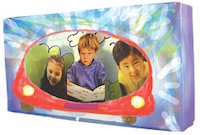Art: You’ve been framed!
Add to My Folder
Jazz up the children’s artwork by making original picture frames

Preparing the children’s work for the wall? Perfecting that display for parents’ evening? Stop! Walk away from the trimmer and put down the sheets of sugar paper, because those masterpieces lovingly crafted by your young Picassos might just deserve better treatment. Why not encourage the children to experiment with designing and making their own range of original frames to present their work in an original and creative way?
The following activities feature a range of practical ideas that should both challenge and enthuse the children’s, ranging from the simple to the complex, the traditional to the innovative. The children should study a selection of possible frame designs in order to appreciate that there are various creative solutions to the problem of making stable structures, before experimenting and constructing their own picture frames. They will also discover ways to maximise the strength of materials like paper and card, and ways in which these materials can be joined simply and effectively. Who knows? Once your frame factory is in full swing, days spent double mounting masterpieces could soon be over!
Introductory activity
- Begin your frames project with a quick, hands-on activity that will introduce the children to some of the key principles that will inform their subsequent investigations. Provide the children with sheets of A4 paper and small quantities of masking tape, then challenge them to invent ways to make their paper stand up – no further instructions should be necessary. Allowing the children a choice of paper (such as cartridge, newspaper and tissue paper) will prompt them to reflect on the properties and suitability of each – those who choose tissue paper because they like the colours will quickly regret their decision!
- After 15 minutes, ask the children to share their work with the class, to identify successful pieces and to explain possible reasons why some structures are more effective than others. Emphasise the key learning points of the task: that the design of the structure is crucial; folding paper, layering it and rolling it into tubes are all effective ways of increasing its strength. Some children will inevitably understand this quickly, and will already be planning their next technological breakthrough, while others may have struggled with the activity. Try to ensure that any problems encountered with this introductory task are addressed, as children will have difficulty moving on to the next task if they are still staring sadly at a pile of soggy tissue paper wondering ‘why’.
Scholastic Resource Bank: Primary - join today!
- Over 6,000 primary activities, lesson ideas and resources
- Perfect for anyone working with children from 5 to 11 years old
- Unlimited access from just £1.25 per month
Already a member? Sign in below.
Published 27 May 2008
Reviews
You need to be signed in to place a review.